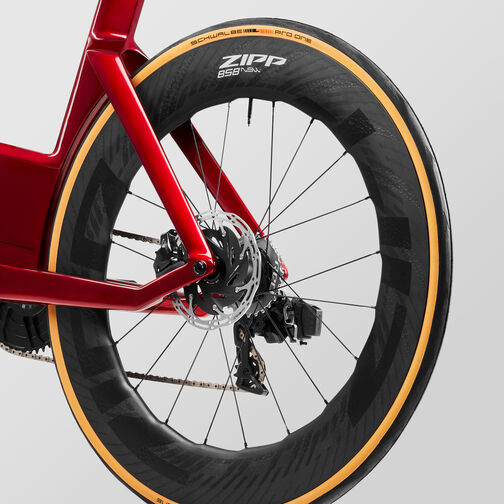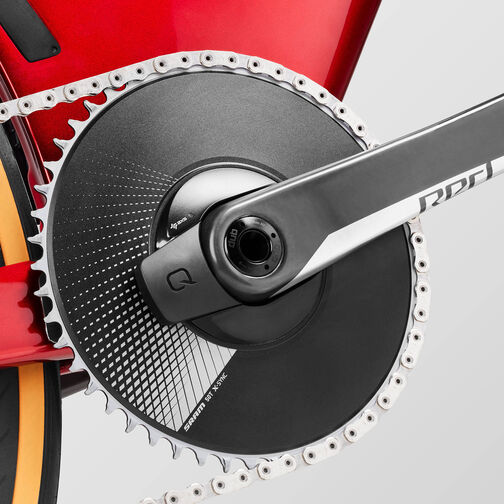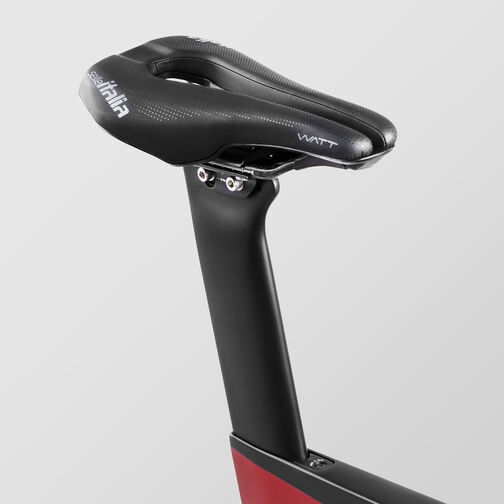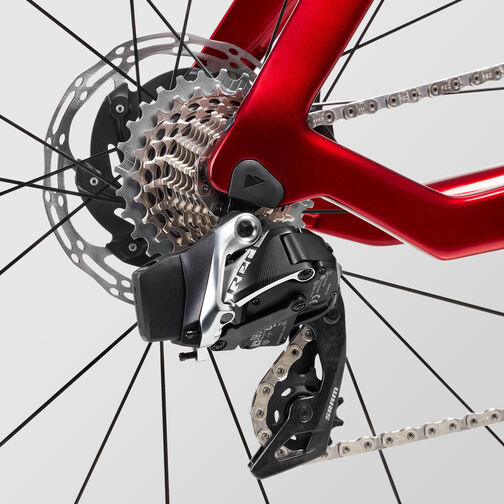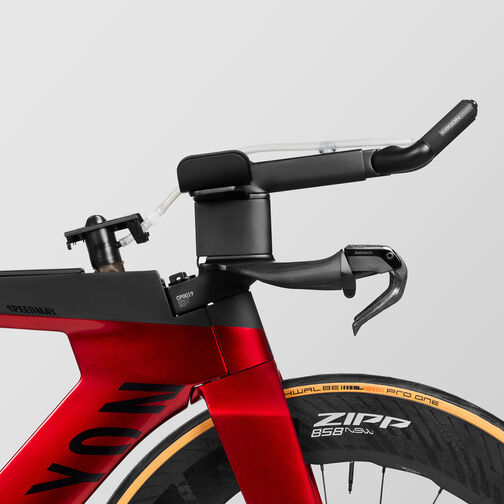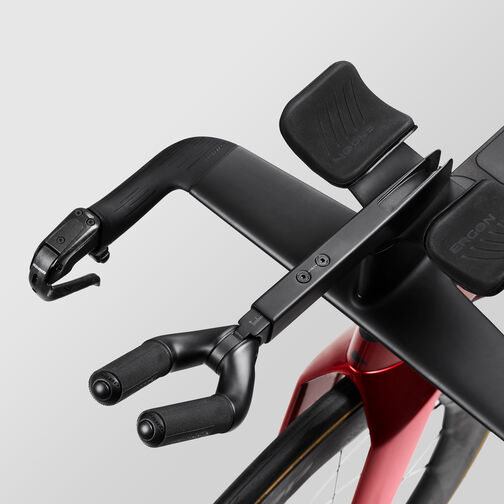Choosing the Right Triathlon Bike: What’s Trending
Featuring the Speedmax CFR eTap
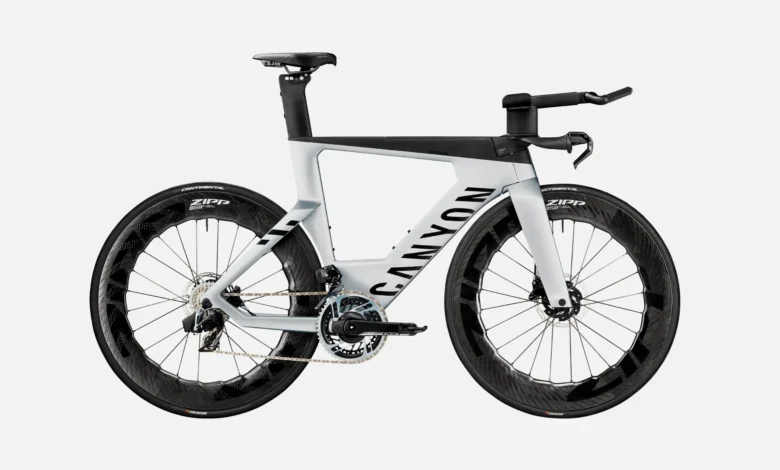
In the fast-paced world of triathlons, the right equipment can make all the difference in achieving your best performance. When it comes to triathlon bikes, staying on top of the latest trends and innovations can give you a competitive edge. In this blog post, we’ll explore the evolving landscape of triathlon bikes and discuss what’s currently trending in the world of endurance sports. From advancements in aerodynamics to the integration of cutting-edge technology, we’ll dive into the key factors to consider when choosing the perfect triathlon bike for your needs. Whether you’re a seasoned triathlete or just starting out, understanding these trends can help you make an informed decision and take your training to the next level.
Understanding the Basics: Triathlon Bikes and Their Importance
Triathlon bikes are specially designed bicycles that are tailored to the unique demands of triathlon races. These races typically involve three disciplines: swimming, cycling, and running. While any bike can technically be used for a triathlon, investing in a dedicated triathlon bike can significantly enhance your performance and overall experience.
The importance of a triathlon bike lies in its ability to provide optimal aerodynamics, comfort, and efficiency. These bikes are designed to minimize wind resistance and maximize speed, allowing triathletes to maintain a consistent and efficient pace throughout the cycling leg of the race. Additionally, triathlon bikes are built with specific geometry and features that promote a more comfortable and sustainable riding position, reducing fatigue and allowing athletes to transition seamlessly to the running portion of the race.
Compared to traditional road bikes, triathlon bikes feature several key differences. One notable distinction is the aerodynamic frame design, which includes aero bars that allow the rider to adopt a more streamlined position and reduce drag. The geometry of a triathlon bike also places the rider in a more forward position, engaging different muscle groups and optimising power output.
Another crucial feature of triathlon bikes is their integration with various accessories and components. These bikes often come equipped with storage compartments for nutrition and hydration, as well as mounting options for electronic devices such as GPS units and heart rate monitors. These technological advancements not only help triathletes track their performance but also contribute to a more streamlined and efficient race experience.
Understanding the basics of triathlon bikes and their importance sets the foundation for making an informed decision when choosing the right bike for your needs. In the following sections, we will explore different types of triathlon bikes and delve into the latest trends that are shaping the industry. By staying abreast of these developments, you can stay ahead of the competition and optimise your performance on race day.
Types of Triathlon Bikes
Triathlon bikes come in various types, each with its own characteristics and advantages. Understanding these different types can help you narrow down your options and choose the right bike that aligns with your specific needs and preferences. Let’s explore the most common types of triathlon bikes:
Road Bikes
Road bikes are a popular choice among triathletes, especially those who are just starting out in the sport. These bikes are versatile and can be used for both training and racing. Road bikes feature a lightweight frame, drop handlebars, and narrow tyres, which make them suitable for high-speed riding on paved roads. While road bikes may not have the same aerodynamic advantages as dedicated triathlon bikes, they offer comfort and manoeuvrability, making them a great option for longer-distance triathlons or those with hilly terrain.
Time Trial Bikes
Time trial (TT) bikes are specifically designed for triathlons and time trial events. These bikes prioritize aerodynamics, allowing riders to cut through the wind and maintain high speeds. Time trial bikes feature a more aggressive and forward-leaning riding position, achieved through a steeper seat tube angle and aerodynamic handlebars known as tri-bars or aero bars. The frame geometry and integrated components of TT bikes help minimize drag, making them the go-to choice for triathletes aiming for maximum speed and efficiency.
Mountain Bikes
While less commonly seen in triathlon races, mountain bikes can be used in off-road triathlons or races that involve rough and challenging terrain. Mountain bikes have a sturdy frame, wide knobby tyres, and a suspension system, which provide excellent traction and stability on uneven surfaces. If you’re considering participating in off-road triathlons or adventure races, a mountain bike would be a suitable choice to handle the demands of the course.
Hybrid Bikes
Hybrid bikes offer a blend of features from both road bikes and mountain bikes, making them versatile for various terrains. These bikes typically have a more upright riding position, wider tyres for stability, and a lightweight frame for efficiency. While not specifically designed for triathlons, hybrid bikes can be a good option if you’re looking for a multi-purpose bike that can handle different types of riding, from training rides to casual commuting.
Understanding the different types of triathlon bikes is essential in determining which bike best suits your triathlon goals and the type of race you plan to participate in. Consider factors such as your experience level, race distance, terrain, and personal preferences when selecting the right bike for your triathlon journey.
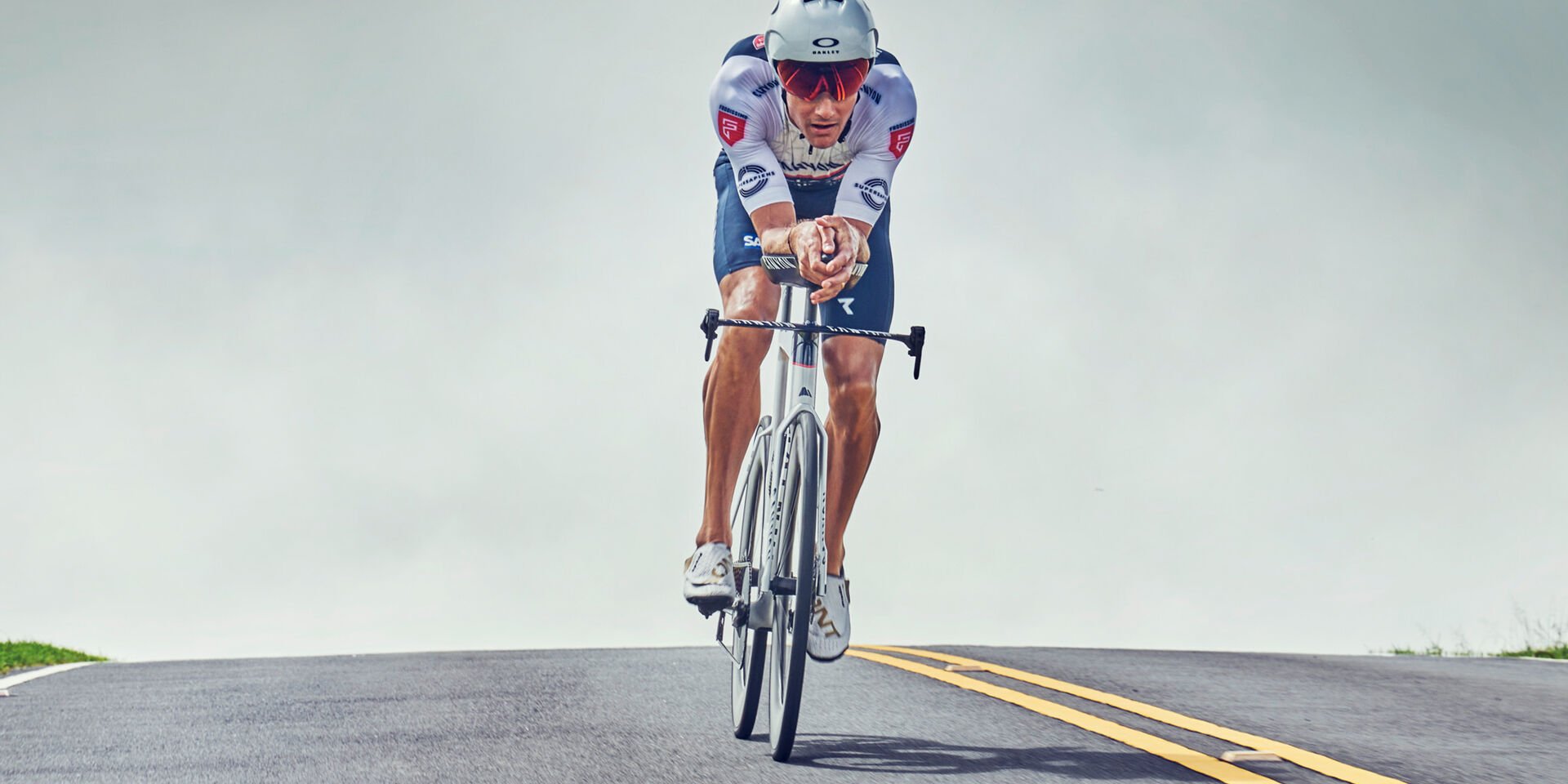
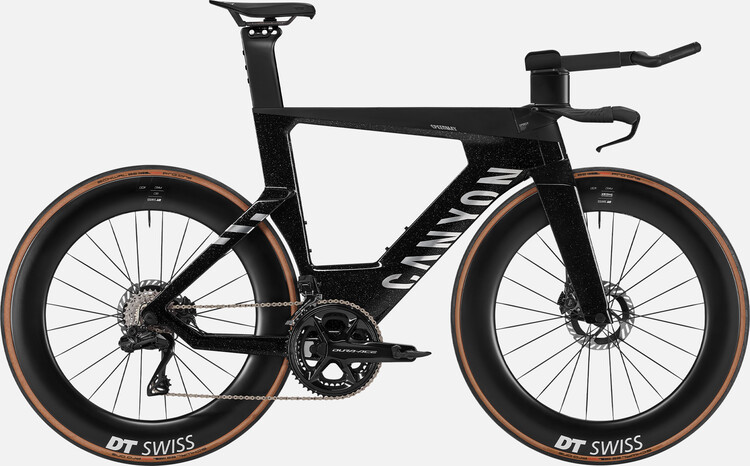
Speedmax CFR Di2 $11,499 £9,050
An aerodynamic integrated hydration system
Adjustable cockpit
Latest Trends in Triathlon Bikes
Triathlon bikes are continuously evolving as manufacturers strive to push the boundaries of performance and innovation. Staying up-to-date with the latest trends in triathlon bikes can help you make an informed decision when purchasing a new bike or upgrading your existing one. Here are some of the current trends shaping the world of triathlon bikes:
Advancements in Aerodynamics
Aerodynamics play a crucial role in triathlon cycling, and manufacturers are constantly finding new ways to make bikes more streamlined and efficient. One of the latest trends in aerodynamics is the integration of hidden cables and internal routing, which reduces wind resistance and creates a sleeker appearance. Additionally, frame designs incorporate features such as integrated brakes, aerodynamic seat posts, and optimized tube shapes to minimize drag and maximize speed.
Integration of Technology
Technology is revolutionizing the world of triathlon bikes, offering athletes enhanced performance monitoring and data analysis capabilities. Many modern triathlon bikes are equipped with integrated GPS units, power meters, and heart rate monitors. Some even feature electronic shifting systems, allowing for precise and seamless gear changes. These technological advancements not only provide valuable insights into your training and racing metrics but also contribute to a more streamlined and efficient riding experience.
Materials and Design Innovations
Manufacturers are constantly exploring new materials and design techniques to improve the performance of triathlon bikes. Carbon fibre remains the material of choice due to its lightweight and rigid properties. However, advancements in carbon fibre layup techniques and frame construction have led to even lighter and stiffer frames, enhancing power transfer and responsiveness. Additionally, frame designs incorporate features like adjustable seat angles and integrated storage solutions to maximize comfort and convenience.
Disc Brakes
Disc brakes are gaining popularity in the world of triathlon bikes, offering improved braking performance, especially in wet or challenging conditions. Disc brakes provide better modulation and stopping power, allowing for greater control and confidence during descents. With increased reliability and reduced maintenance compared to traditional rim brakes, disc brakes are becoming a preferred choice for triathletes looking for optimal braking performance.
Customization Options
Another emerging trend in triathlon bikes is the availability of customization options. Many manufacturers now offer the ability to customize frame colours, component choices, and even frame geometry to better suit individual preferences and body measurements. This allows athletes to create a bike that not only performs at its best but also reflects their personal style and identity.
By keeping track of the latest trends in triathlon bikes, you can make an informed decision when selecting a bike that aligns with your performance goals, preferences, and budget. The advancements in aerodynamics, integration of technology, materials and design innovations, disc brakes, and customization options are all factors to consider when choosing the perfect triathlon bike for your needs.
How to Choose the Right Triathlon Bike
Choosing the right triathlon bike is a crucial decision that can greatly impact your performance and overall racing experience. With numerous options available, it’s important to consider several factors before making your selection. Here are some key considerations to help you choose the right triathlon bike:
Consider Your Budget
Before diving into the world of triathlon bikes, it’s essential to establish a budget. Triathlon bikes can vary significantly in price, ranging from affordable entry-level options to high-end models with advanced features. Determine how much you are willing to invest in a bike and consider the features and components that align with your budget. Remember to also factor in additional expenses such as accessories, maintenance, and bike fitting services.
Evaluate Your Skill Level
Your skill level as a triathlete plays a role in determining the type of triathlon bike that suits you best. If you’re a beginner or relatively new to the sport, a more versatile and budget-friendly bike, such as a road bike or entry-level triathlon bike, maybe a suitable choice. As you progress and gain experience, you can consider upgrading to a more specialized and performance-oriented bike, such as a time trial bike.
Think About Your Goals
Consider your triathlon goals and the types of races you plan to participate in. If you’re aiming for shorter sprints or Olympic distance races, a more versatile bike like a road bike or a triathlon-specific bike would be a suitable choice. However, if you’re targeting longer distance races like Ironman or half Ironman events, a dedicated time trial bike may provide the aerodynamic advantage needed for sustained speed and efficiency over extended periods.
Test Ride Before Buying
Testing out different triathlon bikes before making a purchase is highly recommended. Visit local bike shops or attend demo events to try out various models and sizes. This will allow you to get a feel for different bike geometries, components, and riding positions. Pay attention to factors like comfort, handling, and responsiveness. A test ride can help you determine which bike feels the most comfortable and suits your riding style and preferences.
Seek Professional Bike Fitting
Investing in a professional bike fitting session can greatly enhance your bike’s performance and reduce the risk of injury. A bike fitting specialist will assess your body measurements, flexibility, and riding position to ensure optimal comfort and efficiency. A proper bike fit can also help prevent discomfort or strain during long training sessions and races. Consider scheduling a bike fitting session to fine-tune your position on the chosen bike.
By considering your budget, evaluating your skill level, thinking about your goals, test riding different bikes, and seeking professional bike fitting, you can make an informed decision when choosing the right triathlon bike. Remember that the perfect bike fits your budget, suits your abilities and goals, and provides a comfortable and efficient ride.
Maintaining Your Triathlon Bike
Maintaining your triathlon bike is essential to ensure its longevity, optimal performance, and safety. Regular care and maintenance can help prevent unnecessary wear and tear, keep your bike running smoothly, and extend its lifespan. Here are some key maintenance tips to keep your triathlon bike in top condition:
Regular Check-ups and Cleaning
Perform regular check-ups on your bike to identify any potential issues. Inspect the frame, components, and tyres for any signs of damage, wear, or loose fittings. Check the brakes and gears to ensure they are functioning properly. Clean your bike after each ride to remove dirt, debris, and sweat that can accumulate and cause corrosion. Use mild soap and water, along with a soft brush or cloth, to clean the frame, chain, gears, and other parts.
Proper Storage
Proper storage is crucial to protect your triathlon bike from damage and the elements. Store your bike in a cool, dry place to prevent rust and corrosion. If possible, hang your bike vertically or use a bike stand to avoid placing unnecessary stress on the frame or wheels. Consider using a bike cover or storage bag to shield the bike from dust, moisture, and UV rays. If you need to transport your bike, invest in a bike travel case or bag to ensure it is properly protected during transit.
Handle with Care
Treat your triathlon bike with care to avoid accidental damage. Avoid dropping or banging your bike against hard surfaces. When transporting or moving your bike, be mindful of its delicate components and avoid putting excessive pressure on them. When making adjustments or performing maintenance tasks, use the appropriate tools and follow manufacturer guidelines to prevent any mishaps or damage to the bike.
Regular Lubrication and Component Maintenance
Proper lubrication is essential to keep your bike’s drivetrain running smoothly and to prevent premature wear. Apply lubricant to the chain, derailleurs, and other moving parts regularly, following the manufacturer’s recommendations. Additionally, regularly inspect and maintain other components such as brakes, cables, and tyres. Check brake pads for wear and replace them as needed. Monitor tyre pressure and tread wear, and replace tires when they become worn or damaged.
Schedule Professional Servicing
While regular maintenance can be done by the bike owner, it is advisable to schedule periodic professional servicing for your triathlon bike. A professional bike mechanic can perform a thorough inspection, tune-up, and adjustment of all components, ensuring that your bike is in optimal condition. They can also identify any potential issues that may require attention, such as worn bearings or misaligned components.
By adhering to these maintenance practices, you can keep your triathlon bike in excellent condition and ensure that it performs at its best during training sessions and races. Regular check-ups, proper cleaning and storage, gentle handling, lubrication, and professional servicing are all essential aspects of maintaining your triathlon bike’s performance and longevity.

